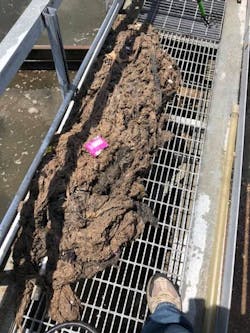About the author:
Cristina Tuser is Associate Editor for WWD. Tuser can be reached at [email protected].
Wastewater treatment is the process of converting wastewater into water that can be discharged back into the environment.
According to the U.S. EPA, one of the most common forms of pollution control in the U.S. is wastewater treatment. The purpose of wastewater treatment is to speed up the natural processes by which water is purified.
What is the purpose of wastewater treatment?
If wastewater is not properly treated, then the environment and human health can be negatively impacted, reported the United States Geological Survey (USGS). Among the impacts are harm to fish and wildlife populations, oxygen depletion, beach closures and other restrictions on recreational water use.
The aim of wastewater treatment is to remove as much of the suspended solids as possible before the effluent is discharged back to the environment, according to USGS.
How is wastewater formed?
Wastewater is formed by a number of activities such as bathing, washing, using the toilet, and rainwater runoff. Wastewater is essentially used water that has been affected by domestic, industrial and commercial use.
Some wastewaters are more difficult to treat than others, according to the Safe Drinking Water Foundation. For instance, industrial wastewater can be difficult to treat due to its high strength nature. Domestic wastewater, on the other hand, is relatively easy to treat.
There are a number of ways in which wastewater can cause pollution problems, considering not all waste makes it to wastewater treatment plants.
Many cities, particularly older ones, have combined sewer systems (CSS), which collect domestic sewage in the same pipes as storm water runoff. After heavy precipitation, street gutters collect more water than the system can hold and a combination of raw sewage and storm water is released directly into the environment, otherwise known as a combined sewer overflow (CSO).
What is the process of wastewater treatment?
There are two main levels of wastewater treatment: primary and secondary treatment.
In the primary stage, solids are allowed to settle and be removed from wastewater. The secondary stage uses biological processes to further purify wastewater. Sometimes these stages are combined, and in some cases additional treatment such as tertiary treatment and advanced wastewater treatment are used.
Primary Treatment
Primary treatment removes material that will either float or readily settle out by gravity. This treatment includes the physical processes of screening, comminution—the act of reducing a material to minute particles or fragments—grit removal and sedimentation.
As wastewater enters a plant for treatment, it flows through a screen. This removes large floating objects, such as rags and sticks, which clog pipes or damage equipment. Once the wastewater has been screened, it passes into a grit chamber, where cinders, sand, and small stones settle to the bottom.
Once the screening process is complete and grit has been removed, the wastewater still contains organic and inorganic matter along with other suspended solids.
These solids can be removed in a sedimentation tank. Biosolids are usually removed from tanks by pumping.
Primary treatment alone is increasingly unable to meet many communities’ water quality standards, according to the EPA. As a result, cities and industries normally treat it to a secondary treatment level and in some cases use advanced treatment to remove nutrients and remaining contaminants.
Secondary Treatment
Secondary treatment removes the soluble organic matter that escapes primary treatment.
Secondary treatment also removes more of the suspended solids, usually by biological processes in which microbes consume the organic impurities as food and then convert them into carbon dioxide, water and energy.
Removal of soluble organic matter at the treatment plant helps to protect the dissolved oxygen balance of receiving stream, rivers, or lakes.
The secondary stage of treatment removes about 85% of the organic matter in sewage by making use of the bacteria in it, according to the EPA. The principal secondary treatment techniques used in secondary treatment are the trickling filter and the activated sludge process.
After effluent leaves the sedimentation tank in the primary stage, it flows or is pumped to a facility using one of these processes. People tend to use the activated sludge process instead of trickling filters, since the activated sludge process speeds up the work of the bacteria.
After the sewage leaves the settling tank in the primary stage, it is pumped into an aeration tank. During this time, the bacteria break down the organic matter into harmless byproducts.
The sludge is now activated with additional billions of bacteria and other tiny organisms and can be used again by returning it to the aeration tank for mixing with air and new sewage.
From the tank, the partially treated sewage flows to another sedimentation tank for removal of excess bacteria. In order to complete secondary treatment, the wastewater from the sedimentation tank is usually disinfected with chlorine before being discharged.
Many states now also require the removal of excess chlorine before discharge to surface waters by a process called dechlorination, according to the EPA.
New methods for removing pollutants are being developed, including advanced waste treatment, filtration, carbon adsorption, distillation and reverse osmosis.
